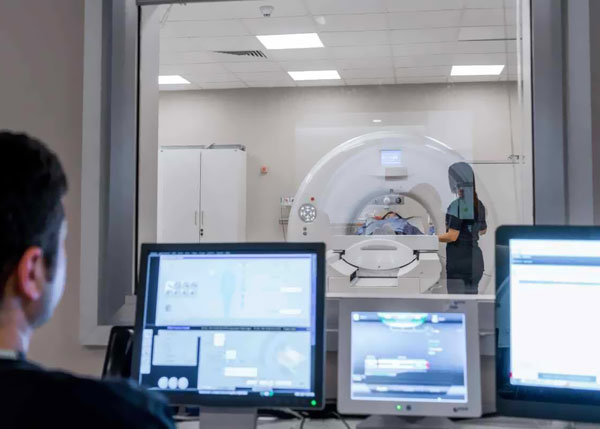Multislice Revolution CT
What is the difference between Multi-slice CT and other types of CT devices? What are the technical specifications of Multi-slice CT?
The difference with Multi-slice CT is the high number of detectors and the high speed of the tube detector system, which rotates around the patient three times per second. The clinical translation of this is that all organs can be scanned in one second and the whole body in 10 seconds.
Volumetric computed tomography (VCT) has made it possible to reduce examination time.
How does the device facilitate diagnosis and treatment, angiography for the patient and the doctor?
* Unlike conventional invasive angiography, volume data can be used to evaluate anatomy from various angles and planes.
*Since it is a non-invasive procedure, there are no complications except for allergies to the contrast dye.
*Provides information on the structure of the vessel wall and plaque, adjacent anatomy, and soft tissues, in addition to endoscopic evaluation.
* Performing routine exams at shorter intervals (during breathing) eliminates image distortion caused by uncontrolled breathing. For example, a 30-centimeter-wide lung exam would take 30 seconds on a traditional CT scanner, but on a multi-slice CT, it can be done in 5 to 9 seconds because of the thinner slices.
*The Quick Scan feature allows a full body scan of a trauma patient to be performed in a very short time.
* Similarly, for pediatric age groups and unconscious patients who are unable to communicate, MSCT allows for a very rapid examination.
*MSCT equipment has made it possible to evaluate subsegmental embolism in patients with sudden pulmonary vascular occlusion, which was previously impossible. Aortic rupture, aortic dilation, atherosclerosis of the extremities, renal vascular disease, pancreatic cancer, liver cancer, kidney cancer, arterial and vascular lesion studies, and liver transplantation can be performed with higher image quality using multi-slice devices, and 3D applications are also possible. CT angiography, which combines fast scan speeds with thin cross-sectional slices, can also be used to evaluate the vasculature of the cerebral vessels.
*Multi-slice CT systems allow for multi-phase contrast-enhanced examinations. For example, in the liver, two consecutive scans can be performed in the arterial phase. Studies have shown that early stages of liver cancer are therefore more likely to be detected in patients with cirrhosis.
*Increasing the scanning speed reduces the amount of contrast agent (intra-arterial dye) administered to the patient, especially in CT angiography.
*The advantage of this test in terms of patient care is that it is non-invasive, does not require hospitalization, can be performed on an outpatient basis, and patients can continue their daily activities after the test.
In which areas is the device used?
Colorectal cancer is one of the leading types of cancer. Since early diagnosis can save lives, traditional colonoscopies are used to screen high-risk patients. However, many patients avoid colonoscopies. It requires sedation during the examination. Virtual colonoscopy has become an alternative diagnostic method for this group of patients. With a CT scan, not only the inside of the colon can be assessed, but also the outside.
This innovation improves image quality and reduces examination time. Thanks to the much thinner slices, diseases that were undetectable with traditional systems can be easily diagnosed.
The anatomical and functional status of the brain can be assessed dynamically. Blood volume, blood flow, and speed of movement in the brain can be calculated. In addition, the Revolution CT scan allows for non-invasive angiography of the blood vessels in the brain and neck.
The image quality degradation observed in previous CT scans, especially in patients with metallic orthopedic materials such as prostheses, was completely improved with Revolution CT.
It is also a reliable technology for non-cardiac vascular, pulmonary, and other CT applications, providing high-quality images non-invasively.
PULMONARY ANGIOGRAM
Multi-slice CT (Revolution CT) can be used for non-invasive imaging of pulmonary vessels and high-resolution imaging of pulmonary embolisms, aneurysms, arteriovenous veins, pulmonary arteriovenous malformation (PAVM), and tumor blood supply.
COMPUTED TOMOGRAPHY (CT) SCAN OF THE CHEST
Multi-slice CT (Revolution CT) provides high-quality images non-invasively during the pulmonary exam. It is possible to carry out virtual bronchoscopy. This technique allows us to visualize the causes of bronchitis and pulmonary disease.
CAROTID ANGIOGRAPHY
With the introduction of Multi-slice CT into clinical use, it has become the golden standard for carotid angiography.
ABDOMINAL, RENAL AND PERIPHERAL ANGIOGRAPHY
Multi-slice CT (Revolution CT) enables non-invasive imaging of atherosclerotic plaques in blood vessels, previously implanted grafts and stents, and emboli causing acute occlusions in a very short time and at high resolution.
CEREBRAL ANGIOGRAPHY
It is possible to dynamically evaluate the brain and its anatomical and functional status. Blood volume, blood flow, and blood flow velocity in the brain can be calculated. Volumetric computed tomography (VCT) also allows for non-invasive angiography of the blood vessels in the brain and neck.
VIRTUAL COLONOSCOPY
Traditional colonoscopy is used to screen high-risk patients because early diagnosis can save lives. However, many patients avoid this test. It requires sedation during the test. Virtual colonoscopy has become an alternative diagnostic method for this group of patients. Multi-slice CT (revolution CT) allows you to evaluate not only the inside of the colon but also the outside.
LUMBAR SPINE IMAGING
In disc herniation imaging, more precise results can be obtained by creating three-dimensional and sagittal coronal and axial images.
Especially in patients with metallic orthopedic materials such as prostheses, the deterioration in image quality observed in old CT examinations is completely improved with Revolution CT.

